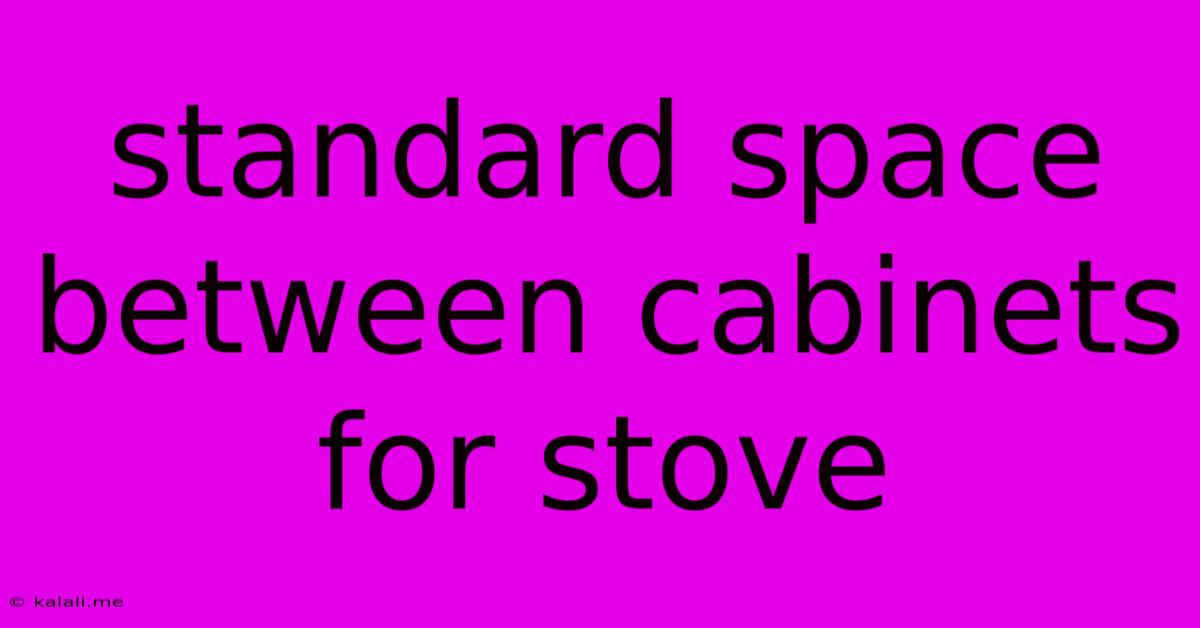Standard Space Between Cabinets For Stove
Kalali
Jun 08, 2025 · 3 min read

Table of Contents
Standard Space Between Cabinets for Stove: A Comprehensive Guide
Choosing the right spacing between your kitchen cabinets and stove is crucial for both functionality and safety. Insufficient space can make cooking cumbersome and increase the risk of burns, while excessive space can lead to a disjointed kitchen design. This guide explores the standard spacing recommendations, factors influencing the ideal gap, and solutions for non-standard situations. Understanding these aspects will help you create a kitchen that's both aesthetically pleasing and highly functional.
Recommended Spacing: The Goldilocks Zone
The standard recommended space between the top of a stove and the bottom of upper cabinets is 18 to 24 inches (46 to 61 centimeters). This range allows for comfortable cooking and prevents accidental contact with hot pots, pans, or the stove itself. Anything less than 18 inches increases the risk of burns and makes using larger cookware difficult. Conversely, distances exceeding 24 inches can make the kitchen feel less cohesive and efficient.
Factors Affecting Cabinet-to-Stove Spacing
Several factors influence the ideal space you'll need beyond the general recommendation:
- Stovetop Height: Different stoves have different heights. Gas stoves tend to have taller burners than electric induction cooktops. Measure your specific stove's height to accurately determine the required cabinet clearance.
- Range Hood Clearance: The space needed for a range hood's installation and operation should be considered. Check your range hood's installation manual for specific clearances. This often adds to the overall vertical space required above the stove.
- Cookware Height: The height of your tallest pots and pans influences the minimum space needed. You need enough clearance to lift pots and pans without hitting the cabinets.
- Personal Preference: While standards exist, personal preferences can sometimes influence this. If you frequently use very tall pots or pans, you might need a slightly larger gap.
Addressing Non-Standard Situations
Sometimes, adhering to the standard 18-24 inch spacing isn't possible due to kitchen layout constraints. Here are some solutions:
- Open Shelving: Instead of full cabinets, consider open shelving above the stove. This can offer a stylish alternative while maintaining safe cooking distance. It's important to carefully consider what you store on open shelving, ensuring only non-flammable items are placed in close proximity to the stove.
- Custom Cabinets: If space is truly limited, consider custom-built cabinets designed to optimize space and still meet safety requirements. A professional kitchen designer can help you achieve a perfect fit.
- Adjusting Cabinet Depth: Shallow cabinets above the stove can create more headroom and still provide useful storage space. This option is usually best when paired with careful planning and potentially custom cabinetry.
Safety First: Beyond Measurement
While adhering to the recommended spacing is vital, remember that overall kitchen safety goes beyond just cabinet placement. Always use caution when cooking, avoid wearing loose clothing near the stove, and never leave a cooking appliance unattended.
Conclusion
The standard space between cabinets and a stove is crucial for both functionality and safety in your kitchen. By considering the factors discussed above and making informed choices, you can create a kitchen design that optimizes both aesthetics and practicality. Remember to prioritize safety and always choose a configuration that ensures comfortable and safe cooking for everyone.
Latest Posts
Latest Posts
-
How To Light The Gas Oven
Jun 08, 2025
-
And One Day I Hope That You Can Find
Jun 08, 2025
-
Sudo Add Apt Repository Command Not Found
Jun 08, 2025
-
Portal Account Owner Must Have A Role
Jun 08, 2025
-
Forgive Them Lord They Know Not What They Do
Jun 08, 2025
Related Post
Thank you for visiting our website which covers about Standard Space Between Cabinets For Stove . We hope the information provided has been useful to you. Feel free to contact us if you have any questions or need further assistance. See you next time and don't miss to bookmark.